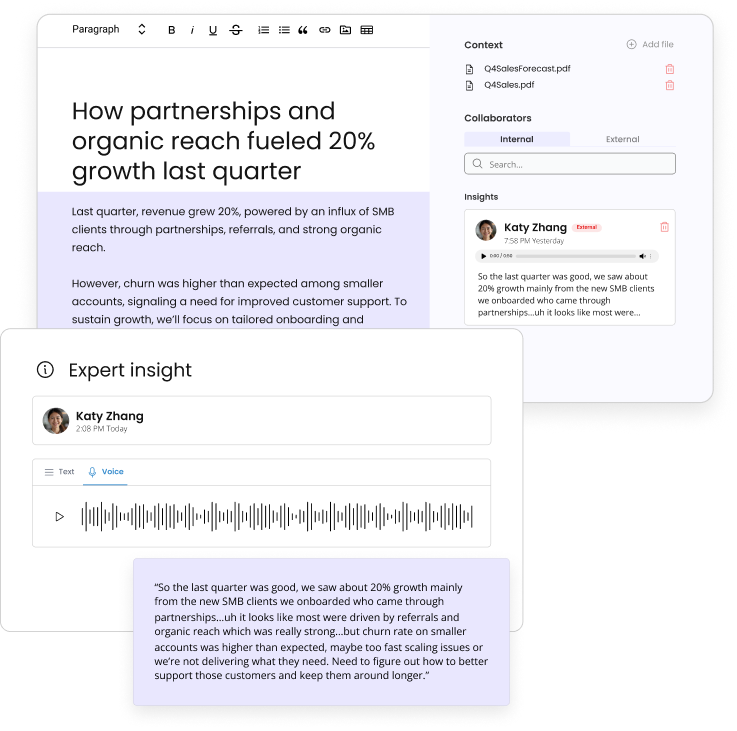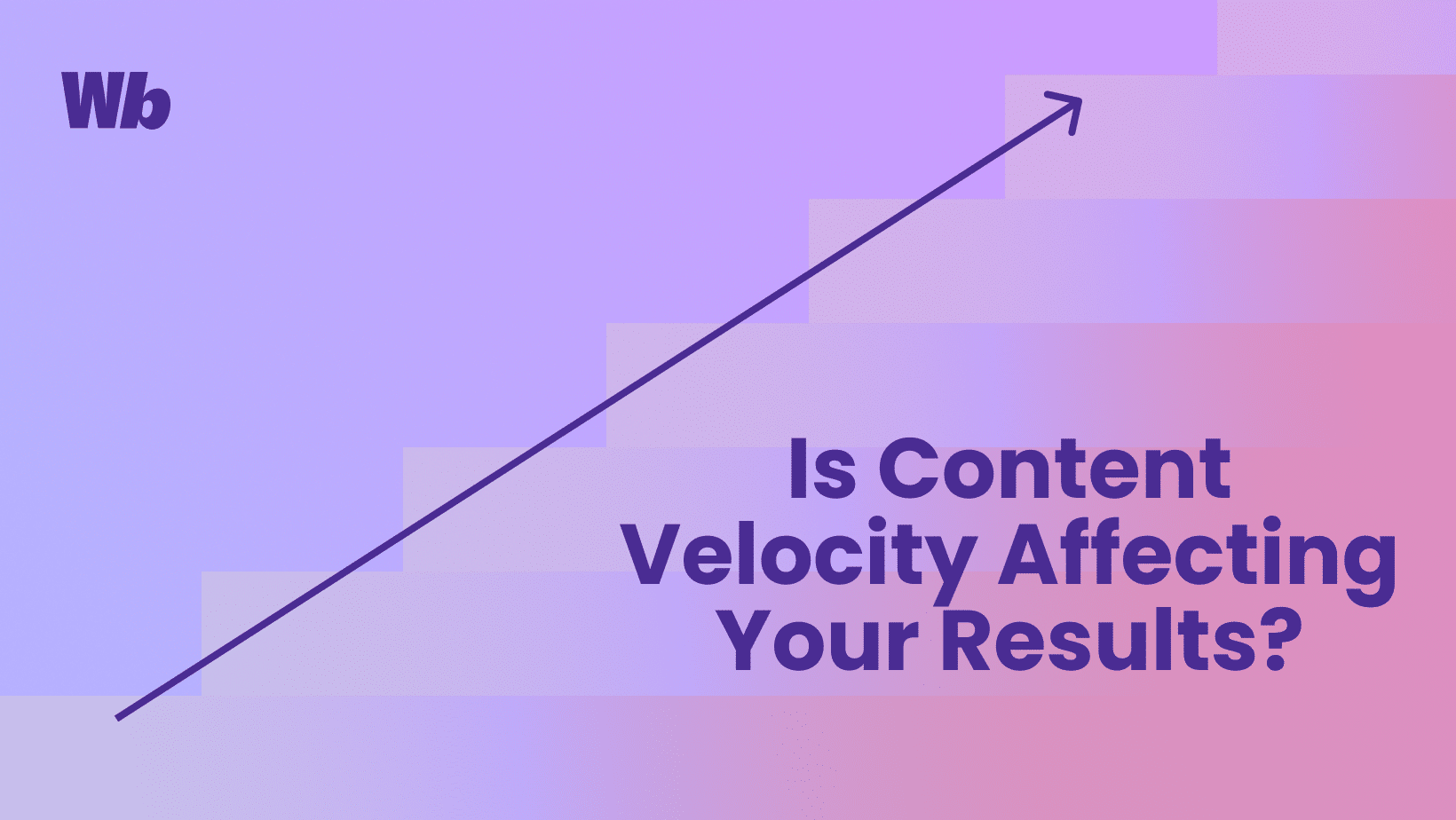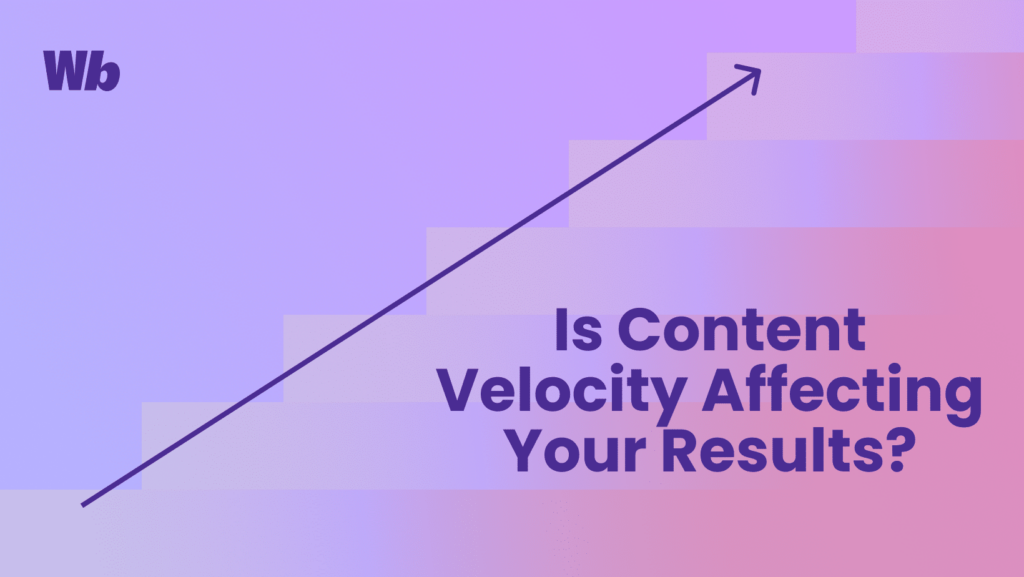Table of Contents

Authority scales when expertise comes first
Wordbrew helps teams collect expert insight before AI ever writes a word.
Built for expert-led, review-safe content
- Home
- »
- Content Marketing
- »
- Is content velocity affecting your strategy’s results?
-
Susan McCullah
- 9 minutes read time
Is content velocity affecting your strategy’s results?
- Home
- »
- Content Marketing
- »
- Is content velocity affecting your strategy’s results?
Is content velocity affecting your strategy’s results?
Table of Contents

“Content is king” is not just a popular adage—it’s key to a brand’s digital prominence. Now more than ever, brands must consistently produce content to better serve and add value to their audience.
Yet, for many, the results of their content strategy still don’t meet the required benchmarks. If you’re dedicated to content creation but not realizing desired outcomes, you’re among many facing the challenge.
Let’s examine the often-underrated component of content strategy: content velocity. We’ll explore its importance, its influence on your strategy, and most importantly, the optimization methods you should consider for optimal results.
What is content velocity?
Content velocity is the rate and regularity at which you generate and circulate digital content. This includes your blogs, social media posts, videos, podcasts, and other content-related initiatives on different channels.
This metric is a crucial aspect of content marketing because it directly affects your ability to engage and retain your audience. Maintaining a rhythm of producing high-value content—in accordance with Google’s E-E-A-T guidelines—and sharing it at a steady pace helps you:
Maintain audience interest
Regular updates feed your audience’s appetite and keep them coming back for more—indicating an active brand presence both to your customers and Google.
Brands that are actively engaged demonstrate not just presence but also a dedication to delivering valuable insights. Plus, an engaged audience signifies a successful content strategy, and consistency is its cornerstone.
Build authority
Without covering your pillar topics and related search terms in enough depth, how can search engines identify your topical expertise? Keeping this in mind, consistent content is foundational—it underlines your brand’s authority and tells search engines that you’re a front-runner in your niche. This commitment not only boosts credibility but also strengthens your brand’s industry reputation.
Reach a wider audience
More content means more opportunities to reach different segments of your target audience and attract new followers or customers. Here, content scaling and velocity equates to more touchpoints with your prospects during their buying journey, tapping into various segments of the target demographic. Every content piece is a chance to impart your expertise—seize it.
Drive conversions
Think about it this way: Content isn’t just about quantity; it’s about alignment with audience needs. Generic, one-size-fits-all content no longer resonates with today’s buyers. Lead generation and sales thrive on tailored content, so your brand must ensure that every piece speaks directly to your audience’s pain points and specific use cases.
Does content velocity matter for SEO?
You bet it does. Regularly updated content signals to search engines that your site is alive and well—phew!
Every time a brand uploads fresh content, search engines take note. After all, search engines are on a perpetual hunt for new, relevant, and quality content to promote to their searchers.
This consistency bolsters search engine indexing and enhances your site’s visibility, which increases website traffic in turn. But, keep in mind that quality and relevancy are the underlying aspects of any successful content strategy.
Content velocity vs. crawl budgets
Search engines allocate a specific crawl budget to each website, dictating the number of pages they will crawl in a given time frame. If a site exceeds this limit due to its vastness and high content velocity, critical pages might be left unindexed, affecting search engine rankings. It’s vital for such sites to meticulously structure their content, prioritizing vital pages and ensuring they are promptly indexed.
Benchmarking against competitors
Every astute content marketing strategy involves a comprehensive study of competitors, and hitting your organization’s most impactful content velocity hinges on understanding your competitors. This competitive insight guides strategic decisions and illuminates areas of opportunity or highlights oversaturation points.
Serious about getting results from your content efforts? Remember to regularly conduct a competitor content audit. But, don’t forget to review:
How often they distribute content
Are your competitors consistently delivering content daily, weekly, or merely a few instances monthly? Your content cadence should match or surpass their rhythm.
Suggested reading: Learn how to create a content distribution strategy.
The types of content they publish
Is their focus solely on blogs, or do they share video content too? Recognizing this can reveal untapped channels to expand your brand reach.
Their engagement metrics
Are their online posts garnering significant attention and discussion? Or do they mostly go unnoticed? Such engagement levels can steer you towards topics that resonate with your audience.
The takeaway: Auditing competitors’ content can yield strategic insights, refining your content blueprint. Plus, you don’t always need to reinvent the wheel.
Estimating content production costs
Understanding content velocity isn’t just about how often you post—it’s key to accurately estimating production costs.
Knowing your content’s flow aids in better financial planning and resource use. And it’s this exact knowledge that helps streamline content marketing spend—ensuring your approach is not only effective but also economically sound.
Consider a tech company that realizes it needs to produce five in-depth articles every month to maintain its audience’s engagement and stay competitive in the industry. To achieve this, they might need to onboard or outsource a content writer.
Here’s how understanding content velocity can guide them in cost-benefit analysis:
Allocating resources
Assessing their content velocity against industry standards means the company can determine how many articles they need to produce to meet or exceed those benchmarks. This insight allows them to optimize and allocate resources, like hiring writers, editors, and designers, more efficiently. Plus, they can determine whether their current team can handle the workload or if outsourcing is a must.
Planning budgets
Knowing the required content output enables the company to create a more accurate content marketing budget. They can estimate the costs associated with content creation, promotion, and distribution, including writer salaries, software subscriptions, advertising expenses, and more.
Assessing ROI
Understanding content velocity helps evaluate the return on investment (ROI) of their content marketing efforts. By comparing the costs associated with producing content to the results it generates, they can assess whether their content strategy is delivering the desired outcomes or if adjustments are needed.
Readying for scalability
As the company grows, they can use insights from their content velocity to plan for scalability. If they wish to increase their content production in the future, they’ll have a clear understanding of the associated costs and resource requirements.
With sound knowledge of your content velocity, your team can balance the creation of ample content with budget constraints. Regular assessment and adaptation of your content velocity ensure the efficiency and effectiveness of your content marketing endeavors in reaching your goals.
Engagement and relevance
Engaging an audience on the jam-packed internet is always going to be challenging. Yet, a consistent stream of valuable content ensures the brand remains memorable to your audience. Capturing and maintaining their attention requires a strategic and consistent approach, and content velocity directly impacts how your brand is perceived by your audience.
Maintaining mindshare
When your audience sees your content regularly, it reinforces your brand’s presence in their minds, positioning you as a go-to resource in your industry. This heightened “mindshare” boosts the chances that they’ll choose your brand when seeking products or services in your domain.
Establishing authority
Content velocity keeps your brand in the spotlight and establishes it as an authoritative figure in your industry or niche. When you consistently produce high-value, informative content in your brand’s voice, you demonstrate your expertise and commitment to providing value. This builds trust and credibility with your audience, making them more likely to rely on your insights and recommendations.
Using an audience-centric approach
To get the balance of engagement and relevance right, periodically survey your audience. Understanding their content preferences, expectations regarding content frequency, and collecting their feedback are essential steps. Why? These insights help shape the cadence and nature of your content production, such as:
- Content preferences: By surveying your audience, you can identify the types of content they prefer. This knowledge allows you to tailor your content strategy to cater to their specific interests.
- Frequency expectations: Audience expectations regarding content frequency can vary widely. Aligning your content velocity with these expectations ensures that you don’t overwhelm or under-serve your audience.
- Feedback loop: When you actively listen to your audience’s comments and suggestions, you can proactively adjust your content strategy. This demonstrates your commitment to meeting their needs.
Potential pitfalls of excessive content velocity
If you’ve heard the saying “too much of a good thing,” it definitely applies here. If you end up with thousands of pieces of content, search engines may have a difficult time identifying a cohesive branding message. Or worse, too much unrelated content can damage your content strategy.
Dilute website authority
An accelerated content release pace can inadvertently dilute the website’s authority. ‘Thin content’—content that lacks depth—can undermine the ability of specific pages to achieve top rankings in search results, leading to reduced website traffic.
Over-optimization
Striking a balance is fundamental in content marketing. An excessive focus on content velocity might create a skewed emphasis on a singular ranking factor. Comprehensive SEO is multifaceted, demanding a blend of keyword research, link building, and on-page optimization to yield positive results.
Losing niche focus
A high content velocity, if unchecked, can lead to publishing an unstructured range of topics. This widespread focus might obscure the core theme of the website, leaving visitors perplexed and questioning the site’s primary intent.
Calculating content velocity as a metric
We’ve talked about what content velocity is and why it’s important. Now, let’s look at how you can calculate it—there are multiple ways to go about it.
The manual approach
Determine the frequency of your content release by simply dividing the number of pieces published by the period (in months or weeks). For instance, releasing 144 articles within a year equates to a monthly content velocity of 12 articles.
Competitor content audit
Stepping into the competitors’ territory offers invaluable insights. You can learn about their publishing cadence either through manual evaluation or save time by using more tools like AlsoAsked, Ahrefs, and Semrush. This data paints a comprehensive image of market trends and potential areas of opportunity for your own strategy.
Internal audit
Regularly scrutinize your content strategy, assessing trends and patterns in your publishing habits. Or, employ tools such as Semrush and Screaming Frog to monitor and optimize content velocity. These audits ensure the brand remains aligned with its content marketing goals.
Improving content velocity
If you look at your current content output and research your competitors’ performance, you may decide your strategy needs work. Improving content velocity is essential for keeping your content marketing strategy dynamic and effective.
Let’s review some actionable tips to enhance your content production speed while maintaining quality and relevance.
Creating a content calendar
A well-crafted content calendar is an invaluable tool for improving content velocity. This structured approach to planning and scheduling content enhances organization, fosters consistency, and ensures the content aligns with the company’s goals.
To create an effective content calendar:
- Start with a clear understanding of your target audience and their preferences.
- Identify broad content themes and topics that align with your brand and goals.
- Set a publishing schedule that accounts for content frequency and platform-specific requirements.
- Assign responsibilities to team members or collaborators for tasks such as research, writing, editing, and promotion.
- Continuously monitor and update the calendar to reflect changes in your content strategy and market dynamics.
Delegating tasks
No matter the size of your team or the scale of your content production, efficient delegation among team members is necessary for achieving consistent, high-value content. Outsourcing your content to an expert at Wordbrew can alleviate even more of the responsibility.
To implement effective delegation:
- Assign tasks: Clearly define roles and responsibilities for each team member.
- Establish communication: Regularly update team members on project progress, share feedback, and encourage collaboration to address any challenges that may arise.
- Control quality: Conduct peer reviews and review editing processes and style guides to ensure consistency and maintain content standards.
Using automation tools
Automation tools are indispensable assets in improving content velocity. They offer a range of capabilities that streamline various aspects of your content strategy, from planning and creation to promotion and analytics.
To effectively use automation tools, ensure you:
- Select the right tools: Identify the specific needs of your content marketing strategy and choose automation tools that align with those requirements. There are various tools available for social media management, email automation, content scheduling, and more.
- Check your integrations: Ensure that your team’s chosen tools integrate seamlessly with your existing workflow and platforms, reducing the need for manual intervention.
- Training and familiarization: Invest time in training your team to use automation tools effectively. Familiarity with the tools’ features and capabilities maximizes their potential.
- Continuous evaluation: Regularly assess the performance of your automation tools and adjust your strategy based on their insights.
Quality over quantity—always
While you should prioritize regularly publishing content, it should never come at the cost of content quality. A single, well-researched blog showcasing your brand’s unique insights and opinions can offer more value than several hastily prepared pieces.
Ask these 3 questions to measure the quality of your content:
- Does the content provide valuable and relevant information to the target audience, addressing their pain points or interests, per use case?
- Is the content well-researched, accurate, and supported by credible sources or data?
- Has the content been optimized for readability, user experience, and SEO, including proper formatting, engaging visuals, and a clear call to action?
Front-loading content strategy
Front-loading your content provides a buffer of ready-to-publish content. It’s a proactive approach that can help you overcome content production bottlenecks and maintain a consistent and high-quality content velocity.
To effectively front-load your content strategy, be sure to:
- Use a content calendar: Create a detailed content calendar that outlines your publishing schedule for the upcoming months. Identify key themes, topics, and publication dates.
- Plan for content creation: Allocate dedicated time and resources for content creation.
- Implement an editorial workflow: Ensure that each piece meets your brand’s guidelines and objectives.
- Use a Content Management System (CMS): This makes it easy to manage and publish on schedule.
Detailed roadmaps and workflows
Precision is the name of the game. Detailed roadmaps and workflows facilitate meticulous planning, ensuring the content integrity remains consistent across all content pieces.
Splintering content
Splintering content is a versatile strategy that involves breaking down comprehensive pieces of content, such as long-form articles or guides, into smaller, more digestible segments. These smaller segments can then be used as standalone pieces of content across various platforms and channels.
To effectively splinter content, ensure you:
- Audit content: Look for comprehensive guides, whitepapers, or in-depth articles that can be repurposed into smaller segments.
- Segment content: Determine how to break down the content into smaller, cohesive segments. Each segment should cover a specific topic or subtopic and stand alone as valuable content.
- Format content: Consider the various formats your splintered content can take, such as blog posts, infographics, videos, podcasts, social media updates, and email newsletters.
- Distribute content: Create a schedule for releasing segments and promote them across relevant channels.
- Interlink content: Use interlinks between splintered content pieces to guide your audience through related topics and encourage further exploration on your website or platform.
Determining an optimal posting frequency
Identifying the perfect blogging cadence isn’t a straightforward endeavor. Several facets come into play:
Goals
Define the primary intent behind your content, be it bolstering brand presence, fostering engagement, or driving conversions.
Resources
Realistically assess available resources. A brand’s financial prowess, manpower, and technical expertise can influence its achievable content velocity.
Audience expectations
Recognize and cater to the unique consumption habits of your target audience.
Content type
Diverse content types demand different production times. Long-form content, with its depth and analysis, might naturally have a lower frequency than shorter, snappy updates.
Creating a content velocity strategy for tomorrow’s success
Content velocity isn’t merely about publishing regularly. It’s fundamentally reshaping how brands communicate and the kind of value they provide to their audience. The brands that thrive will be those that harness this dynamic—blending quality and pace with a clear vision for the future.
Want to delve deeper into optimizing your content strategy for tomorrow’s audience? Explore the resources below:
